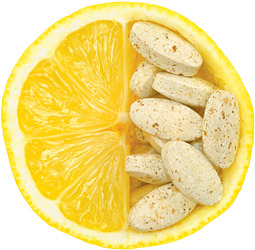The average chiropractor with a typical injury-based practice who does not practice nutrition, sell supplements* or consider nutrition a strong point will often say little to their patients regarding nutrition.
Don't stop taking multivitamins. Whenever we are injured, requirements for nutrients increase; but for some strange reason, many patients stop taking vitamins when they need them the most. The reasoning usually goes like this: "Since I am in too much pain to work out, I figured I didn't need them. If they have a multivitamin, but don't take it, now is the time to take it as directed and continue to do so for as long as they need therapy. If they don't have a multivitamin, advise them to eat foods that are fortified (such as cereals, protein drinks, smoothies or sports bars) at least once a day.
 Take extra vitamin C. Most people have vitamin C around the house and use it when they get colds or infections. Nine out of ten patients are surprised when you tell them vitamin C is also good for injuries. Depending on what you read, dosing can vary widely. For patients with the basic sprain / strain / contusion / inflammatory-type trauma chiropractors commonly encounter, start with approximately 10 mg per pound of body-weight in divided doses with meals.
Take extra vitamin C. Most people have vitamin C around the house and use it when they get colds or infections. Nine out of ten patients are surprised when you tell them vitamin C is also good for injuries. Depending on what you read, dosing can vary widely. For patients with the basic sprain / strain / contusion / inflammatory-type trauma chiropractors commonly encounter, start with approximately 10 mg per pound of body-weight in divided doses with meals.
For example, a person who weighs 140-160 pounds would take 500 mg three times a day while they recover (for injured children, 5 mg per pound). If they don't have any vitamin C, I advise them to pick some up and, if possible, purchase products that include bioflavonoids (at least 50 mg for each 500 mg of vitamin C ), which helps the C reduce inflammation and repair damaged tissues.
Drink two extra glasses of water over what is normally consumed. If a patient asks when and/or how much, one glass in the morning and another in the afternoon at a minimum of 1 ounce for every 10 pounds of body-weight is appropriate.
Eat protein three times a day. Most people get more than the RDA for protein, which is .38 grams per pound of body-weight (normally written as .8 grams per kilogram of body-weight.) However, they may not get .75 grams per pound of body-weight (1.6 gm/kg/bw), which satisfies the extra requirements during times of injury. This is also what is needed for people who are either heavy exercisers or participate in athletic competitions and training.
Maintain your weight. When a person on a weight-loss diet gets injured, have them freeze their food intake at a level that will cause neither weight loss nor weight gain. Make sure they understand that a negative calorie balance (that leads to weight loss) can stress a system that is already stressed and lead to prolonged healing times. Once they feel better, they can decrease their caloric intake and resume their diet.
*Dr. Andersen on selling supplements: I do sell supplements to those patients who need specific micronutrient(s) and/or combinations that are either unavailable over the counter or are more expensive when purchased individually. I do not play either the upsell game or the "only my vitamins work" approach – both of which are done for doctor wealth instead of patient health.
In other words, I will sell supplements if I can save the patient money or replace three bottles of their pills with one bottle of mine; or sell them a professional product that works if the OTC brand(s) they purchased fail and even when all dosing errors [right amount(s) / number(s) at proper time(s)] have been corrected.
Click here for previous articles by G. Douglas Andersen, DC, DACBSP, CCN.





